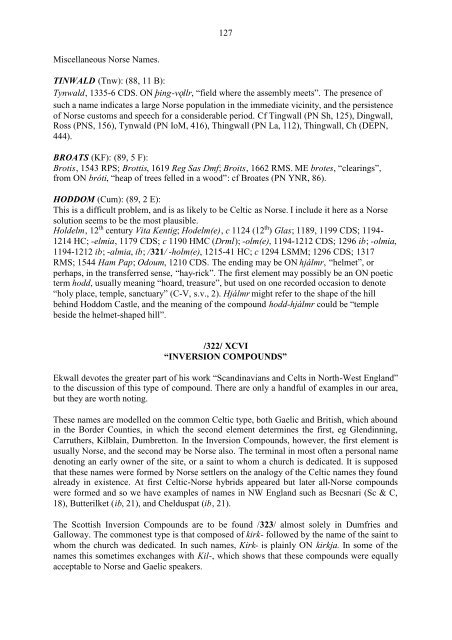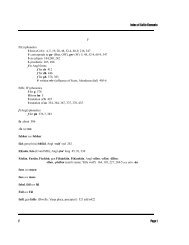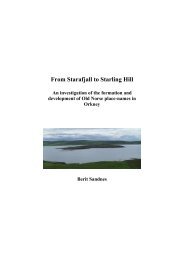May Williamson: The Non-Celtic Place-Names of the Scottish Border ...
May Williamson: The Non-Celtic Place-Names of the Scottish Border ...
May Williamson: The Non-Celtic Place-Names of the Scottish Border ...
Create successful ePaper yourself
Turn your PDF publications into a flip-book with our unique Google optimized e-Paper software.
127<br />
Miscellaneous Norse <strong>Names</strong>.<br />
TINWALD (Tnw): (88, 11 B):<br />
Tynwald, 1335-6 CDS. ON ing-vllr, “field where <strong>the</strong> assembly meets”. <strong>The</strong> presence <strong>of</strong><br />
such a name indicates a large Norse population in <strong>the</strong> immediate vicinity, and <strong>the</strong> persistence<br />
<strong>of</strong> Norse customs and speech for a considerable period. Cf Tingwall (PN Sh, 125), Dingwall,<br />
Ross (PNS, 156), Tynwald (PN IoM, 416), Thingwall (PN La, 112), Thingwall, Ch (DEPN,<br />
444).<br />
BROATS (KF): (89, 5 F):<br />
Brotis, 1543 RPS; Brottis, 1619 Reg Sas Dmf; Broits, 1662 RMS. ME brotes, “clearings”,<br />
from ON bróti, “heap <strong>of</strong> trees felled in a wood”: cf Broates (PN YNR, 86).<br />
HODDOM (Cum): (89, 2 E):<br />
This is a difficult problem, and is as likely to be <strong>Celtic</strong> as Norse. I include it here as a Norse<br />
solution seems to be <strong>the</strong> most plausible.<br />
Holdelm, 12 th century Vita Kentig; Hodelm(e), c 1124 (12 th ) Glas; 1189, 1199 CDS; 1194-<br />
1214 HC; -elmia, 1179 CDS; c 1190 HMC (Drml); -olm(e), 1194-1212 CDS; 1296 ib; -olmia,<br />
1194-1212 ib; -almia, ib; /321/ -holm(e), 1215-41 HC; c 1294 LSMM; 1296 CDS; 1317<br />
RMS; 1544 Ham Pap; Odoum, 1210 CDS. <strong>The</strong> ending may be ON hjálmr, “helmet”, or<br />
perhaps, in <strong>the</strong> transferred sense, “hay-rick”. <strong>The</strong> first element may possibly be an ON poetic<br />
term hodd, usually meaning “hoard, treasure”, but used on one recorded occasion to denote<br />
“holy place, temple, sanctuary” (C-V, s.v., 2). Hjálmr might refer to <strong>the</strong> shape <strong>of</strong> <strong>the</strong> hill<br />
behind Hoddom Castle, and <strong>the</strong> meaning <strong>of</strong> <strong>the</strong> compound hodd-hjálmr could be “temple<br />
beside <strong>the</strong> helmet-shaped hill”.<br />
/322/ XCVI<br />
“INVERSION COMPOUNDS”<br />
Ekwall devotes <strong>the</strong> greater part <strong>of</strong> his work “Scandinavians and Celts in North-West England”<br />
to <strong>the</strong> discussion <strong>of</strong> this type <strong>of</strong> compound. <strong>The</strong>re are only a handful <strong>of</strong> examples in our area,<br />
but <strong>the</strong>y are worth noting.<br />
<strong>The</strong>se names are modelled on <strong>the</strong> common <strong>Celtic</strong> type, both Gaelic and British, which abound<br />
in <strong>the</strong> <strong>Border</strong> Counties, in which <strong>the</strong> second element determines <strong>the</strong> first, eg Glendinning,<br />
Carru<strong>the</strong>rs, Kilblain, Dumbretton. In <strong>the</strong> Inversion Compounds, however, <strong>the</strong> first element is<br />
usually Norse, and <strong>the</strong> second may be Norse also. <strong>The</strong> terminal in most <strong>of</strong>ten a personal name<br />
denoting an early owner <strong>of</strong> <strong>the</strong> site, or a saint to whom a church is dedicated. It is supposed<br />
that <strong>the</strong>se names were formed by Norse settlers on <strong>the</strong> analogy <strong>of</strong> <strong>the</strong> <strong>Celtic</strong> names <strong>the</strong>y found<br />
already in existence. At first <strong>Celtic</strong>-Norse hybrids appeared but later all-Norse compounds<br />
were formed and so we have examples <strong>of</strong> names in NW England such as Becsnari (Sc & C,<br />
18), Butterilket (ib, 21), and Chelduspat (ib, 21).<br />
<strong>The</strong> <strong>Scottish</strong> Inversion Compounds are to be found /323/ almost solely in Dumfries and<br />
Galloway. <strong>The</strong> commonest type is that composed <strong>of</strong> kirk- followed by <strong>the</strong> name <strong>of</strong> <strong>the</strong> saint to<br />
whom <strong>the</strong> church was dedicated. In such names, Kirk- is plainly ON kirkja. In some <strong>of</strong> <strong>the</strong><br />
names this sometimes exchanges with Kil-, which shows that <strong>the</strong>se compounds were equally<br />
acceptable to Norse and Gaelic speakers.




